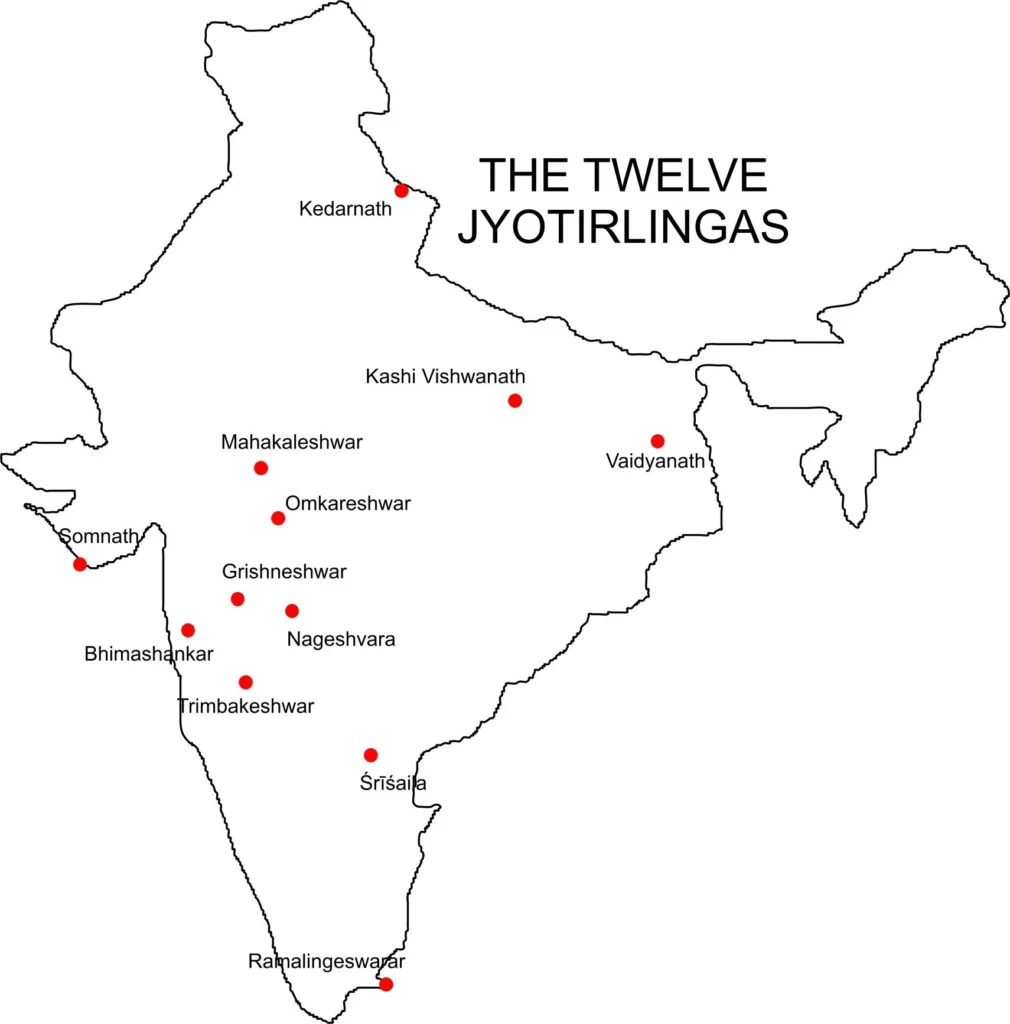A Jyotirlinga is a holy image of Lord Shiva, seen as a ‘pillar of light’ that has no beginning or end. There are 12 main Jyotirlingas in India, believed to have appeared on their own as very powerful places of Shiva’s energy. Millions of devotees visit these temples to pray for blessings, find peace, and honor Lord Shiva through the different stories and traditions linked to each shrine.

Significance of Jyotirlingas
Manifestations of Shiva: Each Jyotirlinga represents a different manifestation or form of Lord Shiva.
Spiritual Liberation: Devotees believe that visiting these shrines can help cleanse karmic debt and lead to spiritual growth and liberation.
Divine Energy: The term “Jyotirlinga” itself means “linga of light,” symbolizing an infinite and radiant divine presence of Shiva.
Pilgrimage: Millions of devotees undertake the “Dwadash Jyotirlinga Yatra,” a pilgrimage to all 12 sites to seek divine blessings and spiritual strength.
Mythology: Pillars of Light & Divine Tales
According to the Shiva Purana, once Brahma, the god of creation, and Vishnu, the god of preservation, argued about who was greater. To settle this, Lord Shiva appeared as a huge, endless pillar of light, called the jyotirlinga, which stretched across the three worlds. Brahma went upward on a swan to find the top, while Vishnu went downward, taking the form of a boar, to find the bottom.
Vishnu honestly admitted he could not find the end of the light, but Brahma lied, saying he had reached the top and even showed a ketaki flower as false proof. Shiva became angry at Brahma’s dishonesty and cursed him so that he would never be worshipped, while Vishnu would be worshipped forever for his truthfulness. The jyotirlinga temples are believed to be the places where Shiva appeared as this infinite column of light.
Each of the 12 Jyotirlinga temples marks a point where Shiva chose to appear. The tradition highlights both his boundless power and his intimate presence across the land.
Historical Background: Glimpses of Time in Stone
These temples are living chronicles. Take Somnath in Gujarat, repeatedly razed and rebuilt over centuries-an enduring symbol of resilience and faith.
Mahakaleshwar in Ujjain features a south-facing Swayambhu lingam and has withstood multiple Islamic raids, including by Iltutmish and the Khilji dynasty, only to be lovingly restored by Maratha patrons.
Geographical Spread of Each Shrine
The 12 Jyotirlingas are scattered across India, each offering a unique spiritual atmosphere.
Here’s a quick list:
- Somnath – Prabhas Patan, near Veraval, Gujarat.
- Mallikarjuna (Srisailam) – Andhra Pradesh
- Mahakaleshwar (Ujjain) – Madhya Pradesh
- Omkareshwar – Mandhata Island, Narmada River, Madhya Pradesh
- Kedarnath – Kedarnath, Rudraprayag District, Uttarakhand
- Bhimashankar – Sahyadri Hills, Pune District, Maharashtra
- Kashi Vishwanath (Varanasi) – Uttar Pradesh
- Trimbakeshwar – Trimbak, Nashik District, Maharashtra
- Nageshwar (Dwarka) – Near Dwarka, Gujarat
- Vaidyanath (Deoghar) – Jharkhand
- Rameshwaram – Tamil Nadu
- Grishneshwar – Ellora, near Aurangabad, Maharashtra
Architecture & Spiritual Experience
Every Jyotirlinga temple showcases its regional architectural creativity-from Srisailam’s gold-plated vimana and Sahasra-linga (thousand) to Omkareshwar’s island-top beauty.
Mahakaleshwar’s inverted Rudra Yantra and the south-facing lingam add mystical significance. In Varanasi, Kashi Vishwanath’s energy is both palpable and transformative.
The 12 Jyotirlinga in India aren’t just sacred shrines-they are portals to mythology, history, art, and inner reflection. Whether you’re planning your own Dwadash Yatra or simply fascinated by India’s spiritual richness, these temples call you.
Frequently Asked Questions (FAQs)
The term Jyotirlinga combines the Sanskrit words Jyoti (light) and Linga (symbol of Shiva), symbolizing the radiant and infinite essence of Lord Shiva. It represents the pillar of divine light through which Shiva manifested himself.
Devotees revere twelve Jyotirlinga temples across India as the most sacred manifestations of Shiva.
Worshipping Jyotirlingas helps devotees connect with Shiva’s formless power, cleanse their karma, and move toward spiritual liberation (moksha).
Shiva revealed himself as an immense pillar of light during a debate between Brahma and Vishnu about supremacy. Neither god found the ends of the light, and Shiva cursed Brahma for lying while pardoning Vishnu for honesty. That pillar formed the basis for the Jyotirlinga shrines.
Devotees typically perform abhishekam (ritual bathing), offer flowers, fruits, and incense, and chant sacred mantras during their worship.
Pilgrims often travel during the cooler months-October to March-or during the sacred month of Shravan (July–August), which holds special significance in Shiva worship.
Somnath (Gujarat): Known as the first Jyotirlinga, symbolizing resilience and faith.
Mahakaleshwar (Ujjain): Famous for the early-morning Bhasma Aarti and its south-facing idol.
Kashi Vishwanath (Varanasi): Believed to grant liberation and free devotees from death’s cycle.



